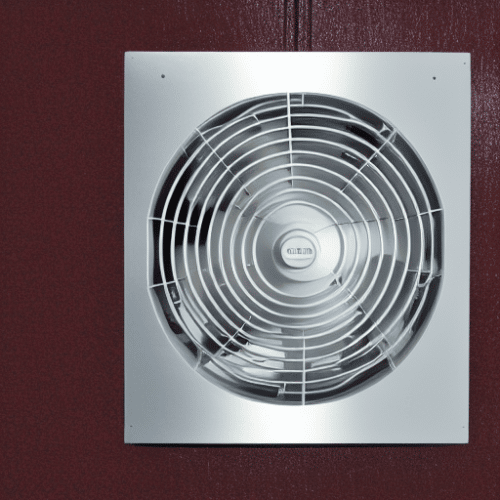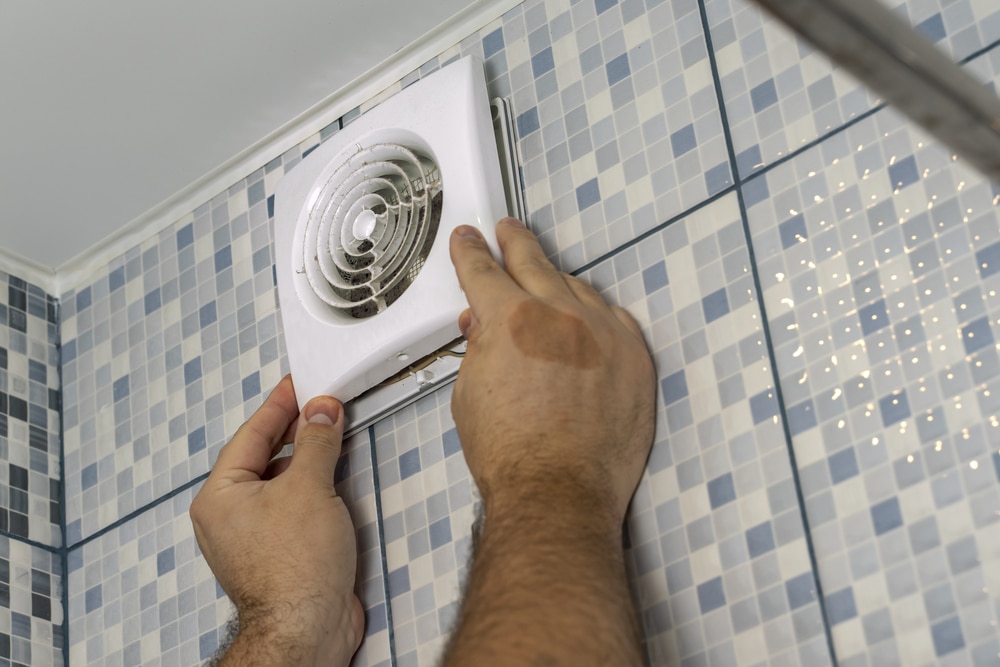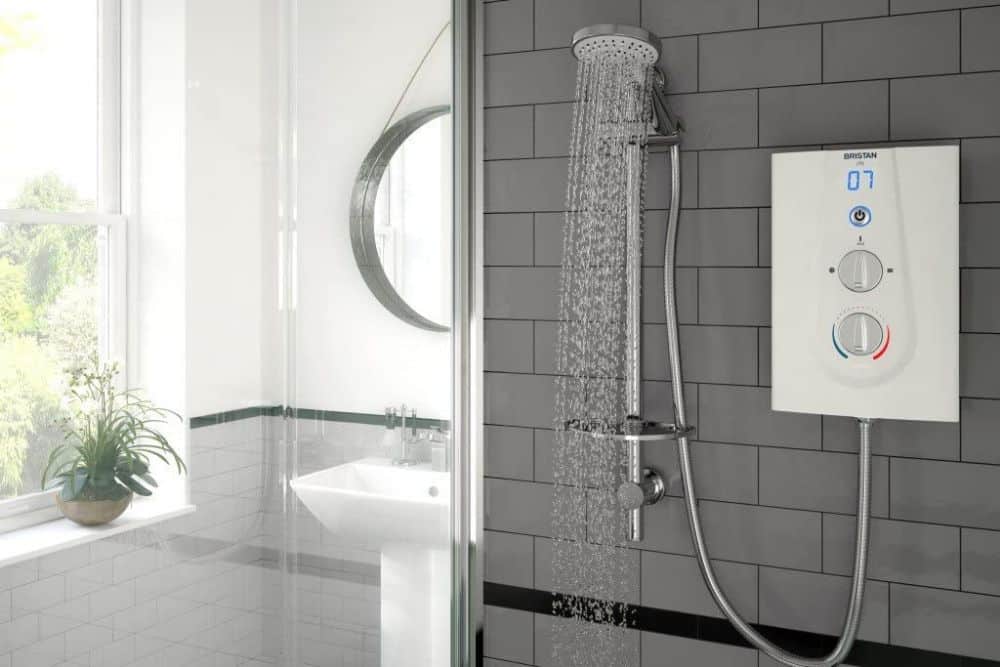Last Updated on
If you are currently remodelling your bathroom and are wondering whether you need to replace your bathroom exhaust or are contemplating adding an extractor fan to an older building, it is not uncommon to have some questions about how a ventilation system like this works. This article aims to help you get a better understanding of why extractor fans can be so important in a home by answering the question of how does an extractor fan work. We also discuss whether or not extractor fans need to vent outside and how kitchen and bathroom exhaust fan models vary.
How an Exhaust Fan Works: The Basics Explained
How Does a Bathroom Extractor Fan Work?
A bathroom extractor fan works as an exhaust system that extracts stale, humid air and expels it through a duct and an outside vent. This makes way for fresh air to replace it, typically coming through a window or door. A bathroom extractor fan uses suction to draw out air and expel it out of a vent. The strength of the fan itself and some of the settings and control options may vary, but for the most part, they all work based on this same basic principle.
Standard fans will not work in bathrooms because, unlike a bathroom extractor, they do not remove air. Instead, it circulates air around a room, creating a breeze.
How Does a Kitchen Extractor Fan Work?
A kitchen exhaust also uses extraction to draw in air. Then, the air is filtered and released through an outdoor vent via ducting. Recirculation hoods filter the air they draw in, but instead of releasing the air outdoors after removing odours, they return it to your kitchen.
What Is a Downdraft Extractor Fan and How Does it Work?

A downdraft extractor is a newer type of exhaust fan designed for use in the kitchen. It fits behind a cooker, and some models can be raised up, and out of the countertop with a button, so they remain hidden when not in use and save space. Other models are integrated into the hob so they can suck the air into the unit as it stays embedded in the countertop.
This type of extraction method sucks steam, odours, and hot air directly off of the hob’s surface before it gets a chance to rise and mix with other air in the kitchen. This gives them a powerful extraction rate and makes them highly efficient. They can either recirculate the air back into the kitchen or force it through a duct to an outside vent, depending on your particular space and needs.
What Are the Benefits of an Exhaust Fan?
So, why is ventilation in the form of extraction so beneficial? Aside from standard home regulations, proper ventilation comes with a number of benefits.
- Extraction removes humidity and moisture from a bathroom. This dissipates steam and prevents exterior surfaces from staying damp for longer than necessary.
- Added ventilation helps preserve the integrity of the bathroom fixtures as well as the paint and plaster found in the wall and ceiling areas. Excess moisture from the showers and sink taps can damage your bathroom if left to sit, but you can simply install an exhaust fan to get rid of it.
- One of the most important benefits of extractor fans is that they prevent mould and mildew from developing due to prolonged condensation. If mould is allowed to develop it can easily build up behind walls and underneath floor tiles which often leads to health concerns for your skin and respiratory system. Mould can also exacerbate asthma symptoms.
- Extractor fans help to eliminate lingering odours, which can be helpful in kitchens and bathrooms alike.
- Turning on your extractor fan can also help by reducing fumes from cleaning products.
Does a Bathroom Exhaust Fan Have to Vent Outside?
Simply put, yes, a bathroom exhaust fan has to be connected to ventilation outside. If the air is vented into the attic or another room of your home, the condensation will not be released and can pose a problem where it is vented. You need to get rid of the moisture entirely. Otherwise, it diminishes its efficiency and can lead to the same downfalls in your attic and ceiling.
Does a Kitchen Extractor Fan Need to Vent Outside?
Unlike a bathroom extraction fan, kitchen ventilation does not have to vent outside, although many still do. You can choose to run a duct from the space over your cooker to the outdoors, but recirculation is also an option, as we discussed above.
Does Every Bathroom Need an Extractor Fan?
Every bathroom requires an exterior way to release steam in order to prevent unnecessary damage. While extraction fans are the most likely solution, an openable window could also work as an alternative, especially in older apartment units and homes. Newer buildings are much better insulated, making the need for an extractor fan more likely.
If you start to notice mould developing, it is a sure sign that you are in need of an extractor fan to establish a bathroom exhaust system.
Extractor Fan Building Regulations
Specific regulations are also outlined regarding exhaust fans. UK regulations state that an extractor fan is needed in a wet room without any openable windows. In newer build projects, a bathroom with only a toilet can get away with having just a window. However, if the bathroom also has a shower, new building regulations state it must contain an exhaust fan even if a window exists in the bathroom.
How to Install a Bathroom Exhaust Fan the Right Way
When installing an extraction fan, placement is key. You want to make sure you place it in an area high on the wall or in the ceiling. It’s best to place it over the shower or near the source of steam and condensation in your bathroom or kitchen. In addition, you will have to consider whether or not it will be connected to ducting that will vent outdoors, as is necessary for a bathroom unit.
Installing an extraction fan could be a DIY project if you consider yourself to be particularly handy, but for most people enlisting professional help is needed if you want to connect ducting correctly. Fortunately, this doesn’t always have to be costly or take much time, especially if the duct is not that long or your bathroom has an exterior wall.
How Do You Know if Your Extractor Fan is Working?
Generally speaking, you will able to tell if your extractor fan is working. However, there is a simple test you can do to double-check. Simply hold a piece of toilet paper up to the intake and turn on the fan. If the toilet paper square is held up by the vent, then your extractor fan is working the way it should.
If not, check the wiring that connects the motor to the switch to make sure it is not loose and tighten with a screwdriver if needed. Rusty bolts could also interfere with the way the electricity flows to the motor, so you may want to begin by replacing them if they show signs of discolouration.
Alternatives to Using an Extractor Fan
Aside from a traditional extractor fan, you may choose to install a different type of ventilation that is thought to be more efficient.
Humidity sensing fans
Instead of being switched on and off with the light in your bathroom, they use a sensor to automatically switch on and off based on the humidity that exists in the room.
Positive pressure ventilation
These units should be used along with a humidity-sensing fan to create a better solution for the entire home. They push fresh air in to cause positive pressure, which forces stagnant air out through extractor fans and other gaps in the insulation.
Mechanical ventilation and heat recovery
This may be the best solution, but it can be hard to install units unless the building is still in progress. These units use ducts in all areas of your home. They send moist, warm air to heat exchange in the loft. The heat exchange adds fresh air from the outdoors and releases warm fresh air back into the home continuously.
A Complete Understanding
After everything that we have learned, you probably feel like an expert on extractor fans by now. As you’ll remember, extractor fans are not a requirement in a bathroom as long as there is an openable window to serve as an alternative. However, the addition of a bathroom exhaust fan can significantly reduce the level of moisture in a room and help to dry damp surfaces that are likely to develop mould and mildew. Extractor fans can also help eliminate smells in the kitchen by filtering the air and drawing it away from your hob. If your bathroom or kitchen does not currently have an exhaust fan, at this point, it is only natural if you are wondering why not and contemplating installing one.
Let us know what you think in the comments below.
Emily is a woman of many talents. She has a B.A. in English and enjoys writing. Emily loves accessorising her home with quality products that not only serve a purpose but also enhance the overall convenience and tranquillity of her living space; there’s nothing like coming home to your own personal sanctuary after a long day! She loves anything that can make life easier or more comfortable—from dishware to furniture to lighting fixtures.



